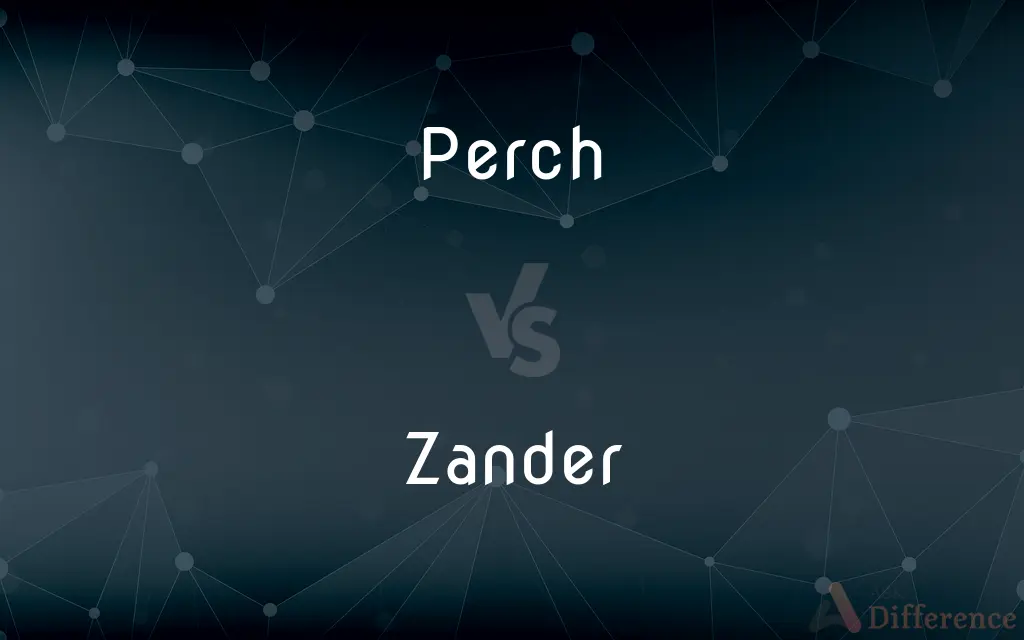Perch vs. Zander — What's the Difference?
By Tayyaba Rehman & Maham Liaqat — Updated on March 27, 2024
Perch are freshwater fish known for their distinct vertical stripes and spiny fins, thriving in lakes and rivers, whereas zander, closely related, prefer similar habitats but are distinguished by their elongated bodies and sharp teeth.

Difference Between Perch and Zander
Table of Contents
ADVERTISEMENT
Key Differences
Perch, belonging to the genus Perca, are easily recognizable by their vibrant green to yellowish body color and dark vertical stripes, making them a popular catch among freshwater anglers. On the other hand, zander, a member of the genus Sander, are prized for their culinary value and sport fishing, featuring a more streamlined, elongated body and a greyish-green to blue coloration, adapting well to various freshwater environments.
While both species thrive in freshwater habitats, including lakes, rivers, and streams, perch often prefer shallower, vegetated waters where they can hunt for prey among the plants. Zander, however, tend to inhabit slightly deeper areas, utilizing their excellent vision in low light to ambush prey, indicating a slight preference for different niches within similar ecosystems.
Perch are known for their schooling behavior, especially when young, providing safety in numbers from predators. Zander, while also capable of forming schools, are more solitary as adults, showcasing a preference for a lone predator lifestyle, which reflects in their hunting techniques and territorial nature.
Dietary habits of perch include small fish, crustaceans, and insects, highlighting their role as both predator and prey within their ecosystems. Zander, with their larger size and sharp teeth, target a broader range of larger prey, including fish and cephalopods, demonstrating their position higher up the food chain.
In terms of reproduction, perch spawn in the spring, laying eggs in shallow, vegetated water, which offers protection and food for the fry. Zander also spawn in spring but prefer slightly deeper, slower-moving water for egg-laying, with the parental selection of spawning sites reflecting their adaptability to different environmental conditions.
ADVERTISEMENT
Comparison Chart
Genus
Perca
Sander
Body Shape
Rounded with distinct vertical stripes
Elongated with a more uniform coloration
Color
Green to yellowish with dark vertical bars
Greyish-green to blue
Habitat Preference
Shallow, vegetated waters
Deeper waters with less vegetation
Behavior
Schooling, especially when young
Solitary as adults, more territorial
Diet
Small fish, crustaceans, insects
Larger prey including fish and cephalopods
Reproductive Strategy
Spawning in shallow, vegetated areas
Spawning in deeper, slower-moving water
Compare with Definitions
Perch
A freshwater fish known for its vertical stripes and spiny fins.
The yellow perch is a common sight in North American lakes.
Zander
Inhabits deeper, less vegetated waters compared to perch.
Zander use their keen vision to hunt in murky waters.
Perch
Exhibits schooling behavior to protect against predators.
Juvenile perch form schools for safety.
Zander
More solitary and territorial as elders, reflecting their predatory nature.
Elders zander are often found hunting alone.
Perch
Prefers shallow, vegetated waters for both hunting and spawning.
Anglers often find perch near underwater plants.
Zander
Reproduces in slower-moving, deeper waters.
Zander spawning habits require specific environmental conditions.
Perch
Consumes a varied diet of small fish, crustaceans, and insects.
Perch play an important role in their ecosystem as predators.
Zander
Targets larger prey, including other fish and cephalopods.
Zander's diet allows them to grow larger than many freshwater fish.
Perch
Spawns in spring, laying eggs among aquatic plants.
Springtime sees lakes filled with perch spawn.
Zander
A predatory freshwater fish with sharp teeth and an elongated body.
Zander are sought after for their sport fishing value.
Perch
Perch is a common name for fish of the genus Perca, freshwater gamefish belonging to the family Percidae. The perch, of which three species occur in different geographical areas, lend their name to a large order of vertebrates: the Perciformes, from the Greek: πέρκη (perke), simply meaning perch, and the Latin forma meaning shape.
Zander
The zander (Sander lucioperca), sander or pikeperch, is a species of ray-finned fish from the family Percidae, which includes the perches, ruffes and darters. It is found in freshwater and brackish habitats in western Eurasia.
Perch
A rod or branch serving as a roost for a bird.
Zander
A food and game fish (Sander lucioperca) of Europe and western Asia, found in fresh and brackish water.
Perch
An elevated place for resting or sitting.
Zander
A European freshwater fish in the family Percidae, closely related to the perch, Sander lucioperca.
Perch
A position that is secure, advantageous, or prominent.
Zander
Any fish of the genus Sander that live in freshwater.
Perch
A pole, stick, or rod.
Zander
A European pike perch (Stizostedion lucioperca) allied to the wall-eye; - called also sandari, sander, sannat, schill, and zant.
Perch
A linear measure equal to 5.50 yards or 16.5 feet (5.03 meters); a rod.
Perch
One square rod of land.
Perch
A unit of cubic measure used in stonework, usually 16.5 feet by 1.0 foot by 1.5 feet, or 24.75 cubic feet (0.70 cubic meter).
Perch
A frame on which cloth is laid for examination of quality.
Perch
Any of several spiny-finned freshwater fishes of the genus Perca, especially either of two edible species, the yellow perch of North America, and P. fluviatilis of Europe.
Perch
Any of various similar fishes of the family Percidae, such as the walleye, or of other families, such as the white perch or the ocean perch.
Perch
To alight or rest on a perch; roost
A raven perched high in the pine.
Perch
To stand, sit, or rest on an elevated place or position.
Perch
To place on or as if on a perch
The child perched the glass on the edge of the counter.
Perch
To lay (cloth) on a perch in order to examine it.
Perch
Any of the three species of spiny-finned freshwater fish in the genus Perca.
Perch
Any of the about 200 related species of fish in the taxonomic family Percidae, especially:
Perch
(South Africa) Acanthopagrus berda
Perch
(Ghana) Distichodus engycephalus, Distichodus rostratus
Perch
(Australia) Johnius belangerii, Macquaria ambigua, Macquaria colonorum, Macquaria novemaculeata, Nemadactylus macropterus
Perch
(USA) Kyphosus azureus
Perch
(UK) Lateolabrax japonicus, Tautogolabrus adspersus
Perch
Several similar species in the order Perciformes, such as the grouper.
Perch
A rod, staff, tree branch, ledge, etc., used as a roost by a bird.
Perch
A pole connecting the fore gear and hind gear of a spring carriage; a reach.
Perch
(figuratively) A position that is secure and advantageous, especially one which is prominent or elevated.
Perch
(figuratively) A position that is overly elevated or haughty.
Perch
(dated) A linear measure of 2 yards, equal to a rod, a pole or 4 chain; the related square measure.
Perch
A cubic measure of stonework equal to 16.6 × 1.5 × 1 feet.
Perch
(textiles) A frame used to examine cloth.
Perch
A bar used to support a candle, especially in a church.
Perch
(theatre) A platform for lights to be directed at the stage.
Perch
(intransitive) To rest on a perch (especially, of a bird); to roost.
The macaw was perched on Jim's shoulder.
Perch
(intransitive) To sit upon the edge of something.
Perch
(intransitive) To stay in an elevated position.
Perch
(transitive) To place something on (or as if on) a perch.
Perch
To inspect cloth using a perch.
Perch
Any fresh-water fish of the genus Perca and of several other allied genera of the family Percidæ, as the common American or yellow perch (Perca flavescens syn. Perca Americana), and the European perch (Perca fluviatilis).
Perch
Any one of numerous species of spiny-finned fishes belonging to the Percidæ, Serranidæ, and related families, and resembling, more or less, the true perches.
Perch
A pole; a long staff; a rod; esp., a pole or other support for fowls to roost on or to rest on; a roost; figuratively, any elevated resting place or seat.
As chauntecleer among his wives allSat on his perche, that was in his hall.
Not making his high place the lawless perchOf winged ambitions.
Perch
A measure of length containing five and a half yards; a rod, or pole.
Perch
A pole connecting the fore gear and hind gear of a spring carriage; a reach.
Perch
To alight or settle, as a bird; to sit or roost.
Wrens make prey where eagles dare not perch.
Perch
To place or to set on, or as on, a perch.
Perch
To occupy as a perch.
Perch
Support consisting of a branch or rod that serves as a resting place (especially for a bird)
Perch
A linear measure of 16.5 feet
Perch
A square rod of land
Perch
An elevated place serving as a seat
Perch
Any of numerous fishes of America and Europe
Perch
Spiny-finned freshwater food and game fishes
Perch
Any of numerous spiny-finned fishes of various families of the order Perciformes
Perch
Sit, as on a branch;
The birds perched high in the treee
Perch
To come to rest, settle;
Misfortune lighted upon him
Perch
Cause to perch or sit;
She perched her hat on her head
Common Curiosities
Where can you find perch?
Perch are commonly found in freshwater environments like lakes and rivers, often near vegetation.
What habitats do zander prefer?
Zander thrive in freshwater but tend to seek out deeper, less vegetated areas compared to perch.
What do perch eat?
Perch have a diverse diet, including small fish, crustaceans, and insects.
What distinguishes perch from zander?
Perch have distinct vertical stripes and prefer shallower, vegetated waters, while zander are elongated predators favoring deeper waters.
What are the conservation statuses of perch and zander?
Their statuses vary by region, with conservation efforts focusing on habitat preservation and sustainable fishing practices.
How do anglers typically catch perch and zander?
Anglers use different techniques, including live bait for perch and larger lures or night fishing for zander.
What makes zander unique among freshwater fish?
Their elongated body, sharp teeth, and preference for hunting larger prey distinguish zander as apex predators in their habitats.
Do perch and zander coexist in the same waters?
Yes, they can coexist in the same water bodies but often occupy different niches due to their habitat preferences.
Are perch and zander related?
Yes, both belong to the same family (Percidae) but are different genera, indicating close but distinct biological classifications.
Can you eat both perch and zander?
Yes, both are considered excellent table fish, with zander being particularly prized in European cuisine.
How do perch and zander reproduce?
Both spawn in spring, but perch lay eggs in shallow, vegetated water, while zander choose deeper, slower-moving water.
What challenges face perch and zander populations?
Overfishing, habitat loss, and pollution are significant threats to both species' populations.
Why are zander considered good sport fish?
Their size, fighting ability, and culinary value make them a popular target among anglers.
How do the behaviors of perch and zander differ?
Perch are more likely to form schools, especially as juveniles, while zander exhibit more solitary and territorial behavior as elders.
What role do perch and zander play in their ecosystems?
Both serve as important predators, helping to maintain the balance of aquatic ecosystems by controlling the populations of smaller fish and other organisms.
Share Your Discovery

Previous Comparison
Fallowing vs. Following
Next Comparison
Manager vs. SupervisorAuthor Spotlight
Written by
Tayyaba RehmanTayyaba Rehman is a distinguished writer, currently serving as a primary contributor to askdifference.com. As a researcher in semantics and etymology, Tayyaba's passion for the complexity of languages and their distinctions has found a perfect home on the platform. Tayyaba delves into the intricacies of language, distinguishing between commonly confused words and phrases, thereby providing clarity for readers worldwide.
Co-written by
Maham Liaqat













































